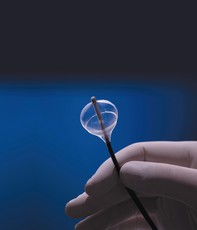| Cardiology | |||
Focused ultrasound used to treat atrial fibrillation15 December 2006 Researchers at the University of Pennsylvania are trialling high intensity focused ultrasound (HIFU) ablation to correct the electrical signals controlling hearts suffering from atrial fibrillation. In atrial fibrillation (A-Fib) the electrical pulses of the heart essentially short-circuit and upset the rhythmic pumping of the heart. Ablation uses intense heat on the area of the heart causing the problems to turn pulmonary vein tissue into scar tissue so that it can no longer conduct electricity. When this is done in several locations, it can effectively stop the symptoms of atrial fibrillation.
The technique used in this trial is the first to deliver energy bursts forward in a complete circle, all at once, from outside of the vein. This invasive procedure is done in the lab with balloon catheters while the patient is awake but sedated. The biggest problem physicians run into with current therapies to cope with electrical rhythmic pumping problems in the heart, namely pulmonary vein isolation procedures, is that up until now, they’ve had to deliver the energy bursts to the tissue in a dot-by-dot catheter ablation procedure around the veins, almost like a string of pearls. “That can cause swelling, and when that swelling goes down, you may still have viable tissue left behind, gaps, where the electricity can still conduct itself or get through,” explains David Callans, MD, director of the electrophysiology laboratory at the Hospital of the University of Pennsylvania and principal investigator of this study. “Now we have a mechanism to construct this barricade of lesions, to do an entire circular ablation, minimizing the potential for gaps behind in the pulmonary veins.” “Since this new system sits outside of the vein, and delivers energy forward rather than immediately around it, there is no damage to the inside of the vein. This maintains a normal blood flow. Plus, this new system could shorten the ablation procedure time which currently takes about four hours,” adds Callans. Penn Medicine, which has one of the largest cardiac electrophysiology programs in the country, has been doing atrial fibrillation ablation procedures for the last several years. Callans states, "Ablation is definitely the future for treatment of atrial fibrillation. Everything else we currently use to treat A-Fib is flawed. So the ablation procedure itself has to improve, become more effective and safer. And one way we can do this is on the technology front by developing better tools. This trial may be a big part of that."
|
